What comes to mind when you think of traveling to Salvador,Brazil? Maybe sun-soaked beaches, vibrant samba-filled streets, Jiu Jitsu and Capoeira, or caipirinhas paired with savory meats.
You might also picture a Bahian woman in traditional dress of a white blouse, colorful skirt, headwrap, and layered beads.
In Salvador, you’ll find all of this and so much more.
In this article, I share a 3-day itinerary including tips for visiting one of the oldest cities in the western hemisphere and my favorite places to eat and explore in Salvador, Brazil.
Salvador’s Historical Importance
Salvador was the first capital of Brazil from 1549 to 1763. The capital then moved to Rio de Janeiro and finally Brasília, where it remains today.
The city was one of the most strategic in the Americas and Salvador’s location on the Bay of All Saints served as a key maritime port. Furthermore, the capital was conveniently located in the middle of the 4,500-mile-long Brazilian coastline.
Brazil’s primary industries at the time were sugarcane and the transatlantic slave trade.
Four million Africans arrived in Brazil through Salvador, bringing their traditions, cuisine, and religion —elements that now form the foundation of the city’s rich culture.
Today, Salvador is a sprawling city of 4.2 million and its historic center is a UNSECO World Heritage Site. Walking the streets it is easy to feel the cultural influences of the Europeans, Africans, and Indigenous who built this city from the ground up over 500 years ago.

Top 5 Reasons to Visit Salvador
Salvador can be overlooked by the traveler lured by Rio de Janeiro’s beaches or São Paulo’s mega-city vibes but it deserves as much consideration.
- HISTORY – As the first capital of Brazil and a major maritime trade center during colonial exploration times, Salvador has an impactful story to tell dating back to the 1500s
- CULTURE – The African influences throughout the city place Salvador at the center of Afro-Brazilian culture in Brazil
- CUISINE – Bahian cuisine is rich and full of flavor. You’ll be hard-pressed to find a better bowl of moqueca or acarajé outside of Salvador
- BEACHES – The Salvador and greater Bahian coast offer warm and tranquil waters year-round. The city has one of the longest coastlines in Brazil, stretching 50 miles
- CARNIVAL – The 6-day street party that occurs every February and is the biggest in Brazil. Unlike Rio where Samba dominates, Bahian Carnival features Axé music, a blend of Brazilian pop, African rhythms, and Caribbean styles of music
When to visit Salvador
Thanks to its tropical climate, Salvador’s weather ranges from warm to hot with a mix of rain showers throughout the year.
Travelers can expect less rain and more heat between October and February. This time of year is the most popular time to visit Salvador, with the summer months of December, January, and February being the busiest.
If visiting in February, be cautious of planning a trip around Carnival. Hotel and flight prices will generally be more expensive in February.
Visiting Salvador in March
We planned our visit at the end of March in hopes of still being able to enjoy the warm summer weather and minimal rain while also avoiding crowds. During our visit, daytime highs were in the mid-80s with lows in the upper 70s.
It rained every day but was always in quick, passing spurts. Carrying an umbrella is a good idea as it was too hot to even think about wearing a rain jacket.
When we arrived, it was raining and the sun had just set. The streets around our pousada in Pelourinho felt empty and unwelcoming.
However the next morning the sun was shining and you could feel the inviting energy of the historic city center of Pelourinho just from the balcony of our hotel room.

View of All Saints Bay
Preparing for Your Trip to Salvador
“Brazil is not for beginners” – Brazilian composer, Tom Jobim
Leading up to our trip, everytime we mentioned to Brazilians that we were visiting Salvador they would instruct us not to wear any jewelry, not to walk around at night or even down empty streets during the day, and not to accept “presents” from vendors on the street.
None of these warnings were new to us but they demonstrated that even Brazilians adhere to the same precautions and felt very strongly about making sure we understood the potential dangers in the city.
There are panhandlers along with city-vetted and non-vetted street vendors who can become pushy at times. If you’re uninterested in what they have to offer, it is best to politely say no thank you and keep walking. They will eventually leave you alone.
5 Tips for navigating the Salvador safely
- Plan Ahead – If you will be walking, know your route to avoid having to use your cellphone and try to always use busy, well lit streets.
- Use a Fannypack – Luckily fanny packs or crossbody bags are in-vogue and they’re super convenient while being the safest way to carry your belongings.
- Leave Your Bling at Home – Opt for simple accessories that are not eye-catching. We did wear our Apple watches but avoided wearing necklaces that can be easily pulled off.
- When in Doubt, Just Uber – Uber is safe and reliable in Brazil. We usually love walking in new cities but chose to rely more on Uber in Salvador as a measure of safety.
- Nothing Is Free – Know that if someone offers you a bracelet or body paint, lets you join in on their Capoeira or drum session, or wants to take a photo with you, they will expect payment in return.
If it is your first time in Brazil, Salvador is an ambitious city to visit, especially for the sporadic traveler. While we never felt in danger, there were moments of unease where we needed to exercise caution and be more aware of our surroundings.
These sentiments can be true of any big city (including most in the U.S.) and should not be interpreted as a reason to avoid Salvador. The pros of visiting strongly outweigh any cons that honestly are not unique to Salvador in South America.
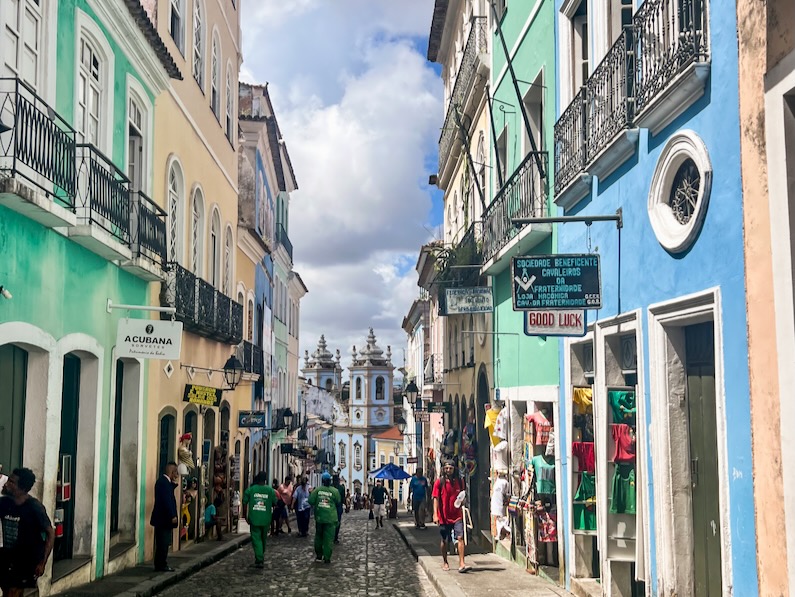
Salvador 3-Day Itinerary
DAY ONE
- Hotel check-in at BahiaCafé Hotel
- Dinner at Restaurante Maria Mata Mouro
DAY TWO
- Breakfast at hotel
- Airbnb Experience guided walking tour of Pelourinho
- Visit the Museu da Gastronomia Baiana
- Lunch at Restaurante Tropicália
- Ice cream at Cubano Sorvetes
- Stroll through the Feira de São Joaquim
- Sunset at Ponta do Humaitá
- Dinner at Cuco Bistrô
DAY THREE
- Breakfast at hotel
- Capoeira lesson at Barra Lighthouse
- Visit the Bahia Nautical Museum
- Stroll the Praia do Farol da Barra to Morro do Cristo
- Grab a pint of craft beer and lunch at ArtMalte
- Visit a Casa do Rio Vermelho museum
- Snack on acarjé from Acarajé da Cira
- Sample infused cachaça at Bar do Cravinho
- Enjoy the sunset and a cocktail at Antique Bistrô
- See the Balé Folclórico evening performance
Continue reading for more details about this itinerary in Salvador!
Day 1 in Salvador
The Salvador airport is 45 minutes by car northeast of Pelourinho or the historic center.
The Pelourinho neighborhood is a good base for tourists coming to Salvador. Many of the city’s top tourist attractions, historical churches, and museums are in Pelourinho. The food scene in Pelourinho is also plentiful with many options at all price points.
However, Pelourinho is not near a beach and can be flooded with street vendors.
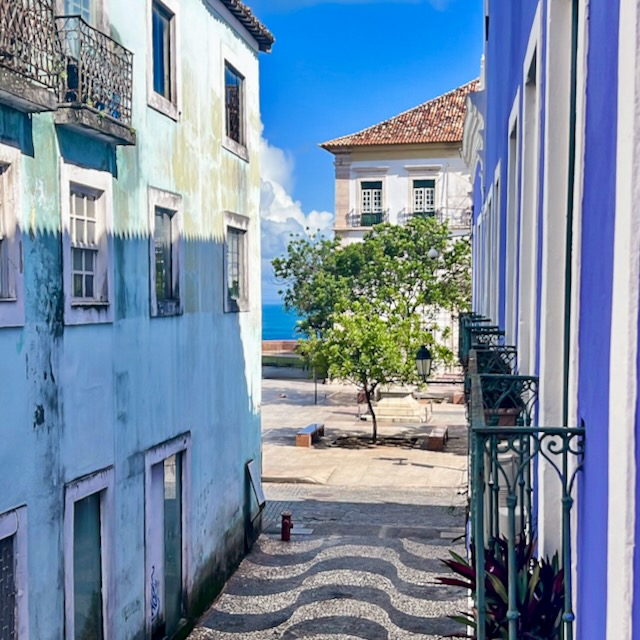
View from Hotel Room Balcony
Bahiacafé Hotel in Salvador
Bahiacafé Hotel felt like a refuge in the middle of Pelourinho.
The hotel is conveniently located off of the Praça da Sé. Although our room was only on the second floor of the hotel, it was mostly protected from the nighttime noise in the plaza out front.
If you’re worried about noise, I always recommend a travel sound machine. They are life (sleep) savers!
Dinner at Restaurante Maria Mata Mouro
A four minute walk from Bahiacafe Hotel is Restaurante Maria Mata Mouro. On the walk, we began to feel the immense presence of the historical buildings and churches that line the praças in Pelourinho.
The house cocktail is called the Meladinha. It is made with cachaça, ginger simple syrup and lime. We’ve since tried to make a copycat version of Meladinha at home.
For dinner, I recommend the Camarão or Shrimp Cacio e Pepe, Bruscheta de Tomate Assado, and Arroz de Frutos do Mar.
Day 2 in Salvador
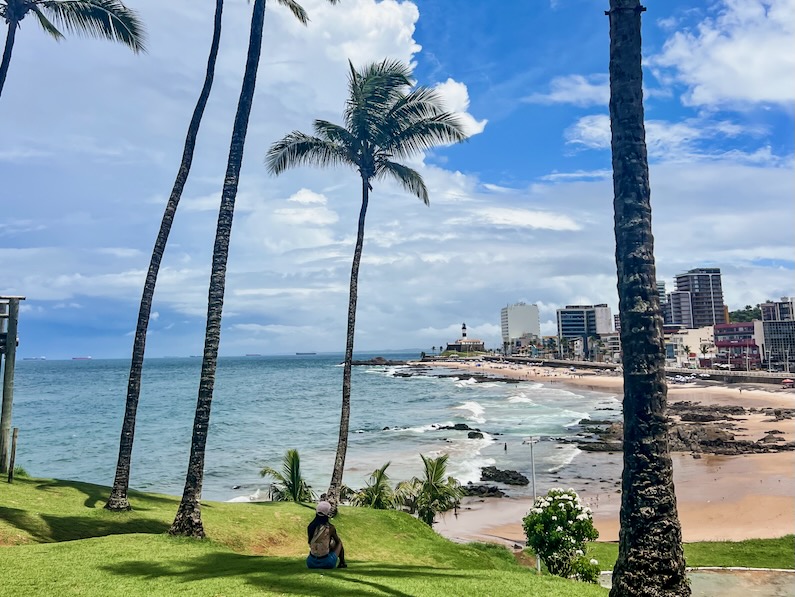
Guided Walking Tour of Pelourinho
Guided walking tours are an excellent way to explore an area like Pelourinho. The neighborhood is overflowing with history.
However, unless you’ve spent hours absorbing information ahead of your visit, walking around and reading a few placards will not provide the same enriching experience as a guided tour with a local.
5 interesting about Salvador from the tour
- The Portuguese built their cities on hilltops close to the ocean. Salvador, being the Portuguese’s first colonial capital in the Americas, is no different and has many similarities to Lisbon.
- The Igreja da Sé or Old Cathedral of Salvador, was the first cathedral constructed in the city in the 1500s. However, in favor of city modernization, it was torn down in 1933 to make way for a trolley. The trolley was eventually discontinued in favor of cars but today no cars are permitted to pass through the area of the original church.
- The building that houses Salvador’s present day City Hall was constructed in the 1980s in fewer than 15 days. It was meant to be a temporary building. However, it is still standing today amidst immense colonial buildings built hundreds of years prior.
- The Igreja e Convento de São Francisco, the most elaborate church in Salvador, was built by slaves and indigenous peoples who had never seen a Baroque style church. Thus the faces of sculptures inside are not quite the same as Baroque churches found in Europe. In 2025, the part of the roof caved in and tragically killed 1 tourist and injured several others.
- The historic center is called Pelourinho or in English, pillory. It was given this name because the main square or praça was the location where African slaves were brutally and publicly punished.

Inside of Igreja e Convento de São Francisco
More about the walking tour in Salvador
Our amazing guide was an architect and urban planner who was super knowledgeable of the area and the greater Salvador region.
The tour began near the Elevador Lacerda, weaved through the various praças or plazas, and concluded in front of the Fundação Casa de Jorge Amado.
I booked the 2.5-hour tour ahead of time through Airbnb Experiences but there are free options available through sites like Free Walker Tour and Civitais.
Another advantage of participating in a walking tour, especially in a busy and sometimes chaotic area like Pelourinho, is that you’re not approached by vendors or panhandlers as much.
Before the tour started, our guide provided a similar explanation of how to safely enjoy Salvador that we’d heard before.
I believe we felt more comfortable taking our time walking, standing around, speaking English, and taking photos in the presence of our guide than if it had just been the two of us.
During the tour we visited these local shops to purchase authentic souvenirs:
- Regina Navarro BellaOyá: Bahian clothing and accessories
- Cabuloso Atelier de Arte e Cultura: paintings of Salvador by local artists
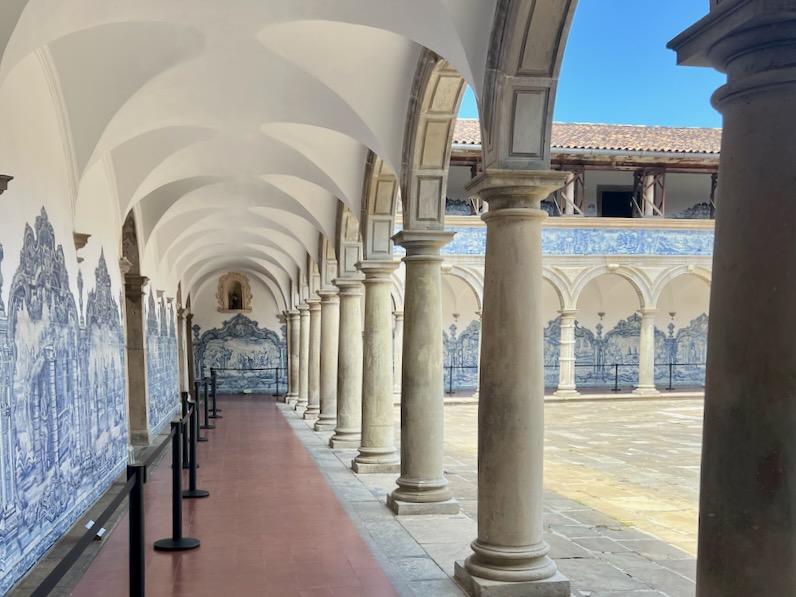
Original blue tiles in the Igreja e Convento de São Francisco
Museu da Gastronomia Baiana
Following the walking tour, head over to the Museu da Gastronomia Baiana.
This two-room museum is a quick visit but offers worthwhile information about the roots, ingredients, and methods of cooking Bahian cuisine.
Although the information is mostly in Portuguese, there are many photos and artifacts in the exhibit. Museum entry is free and is open every day from 8 am to 4 pm.
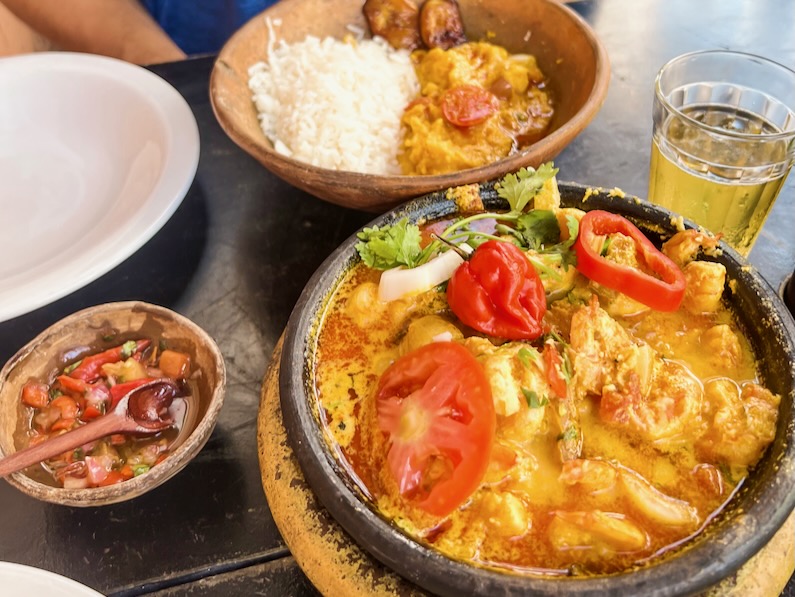
Moqueca: A popular seafood dish with dendê oil
Lunch & Ice Cream in Pelourinho
For lunch, our guide recommended the delicious Restaurante Tropicália.
We enjoyed cold Spaten beers and a bowl of moqueca for two at a table on the sidewalk, which allowed for some great people-watching.
Even though we were stuffed with moqueca, we knew we had to try the famous Cubana Sorvetes.
Luckily, we didn’t have to walk far since they have a location just down the street from Restaurante Tropicália. We choose to taste two of their most popular flavors: Coco and Nata Goiaba.
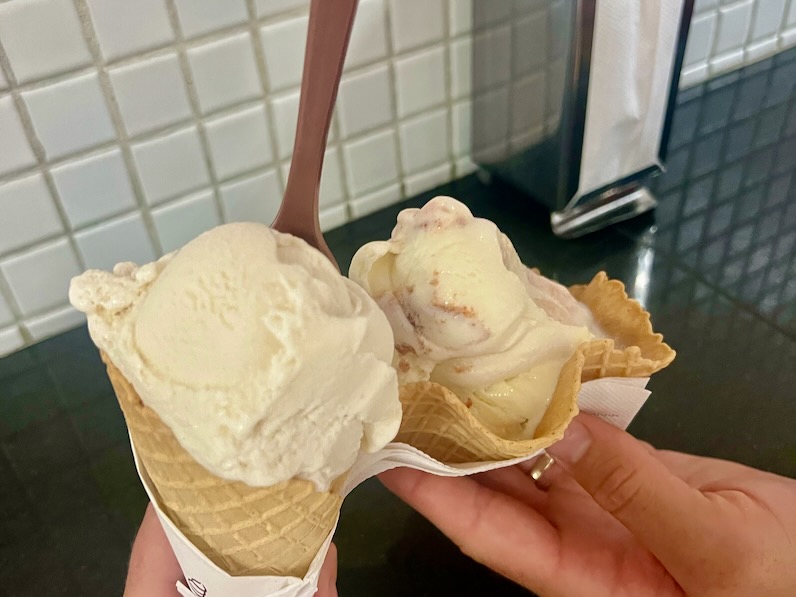
Ice Cream from Cubana Sorvetes
Feira de São Joaquim
Following ice cream, grab an Uber to the Feira de São Joaquim. This market is more traditional than the touristy Mercado Modelo near the port.
Here you can browse the stalls full of local ingredients and even some Candomblé things at the Feira de São Joaquim.
A visit to the Feira de São Joaquim would be enhanced by a guide who could explain the origin and use of some of the unique fruits, vegetables, spices, fish, and meat sold at the market.
While we enjoyed browsing, it was a little chaotic – but in a good way. I’m pretty sure we were the only non-locals there at the time of our visit. This stop may not be for everyone but if you enjoy catching a glimpse of every day life when you travel its worth it.
After a few laps around the market, grab an iced cold beer at one of several very casual restaurants located behind the market on the Bay of All Saints.
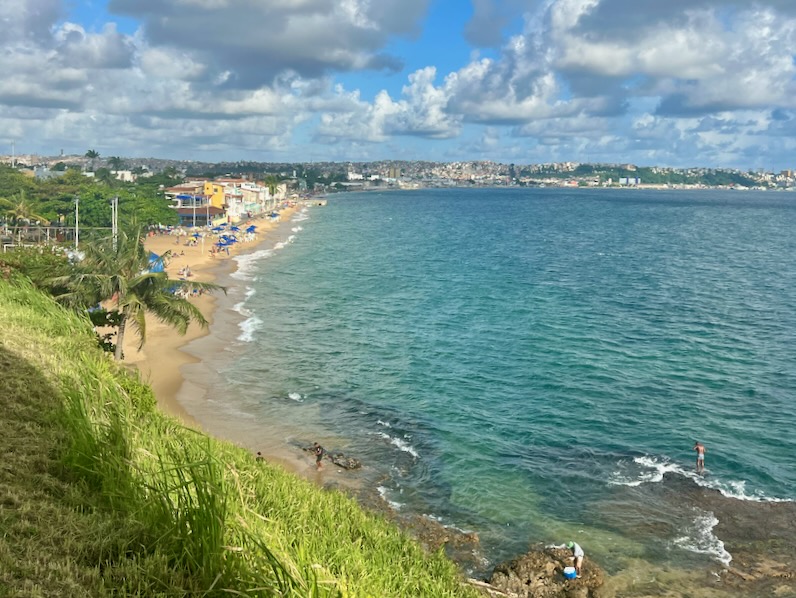
View of the Bay of All Saints from nearby Feira de São Joaquim
Ponta do Humaitá
From Feira de São Joaquim continue Ubering north towards Ponta do Humaitá.
Ponta do Humaitá is a well-known spot to watch the sunset over the Bay of All Saints. There is also a fort, Forte de Monte Serrat, and a catholic church, Igreja e Mosteiro Nossa Senhora do Monte Serrat, worth checking out before sunset.
Kiosks sell cold beverages to enjoy while you take in the sights – pick-up soccer games and a few people fishing on the pier before sunset.
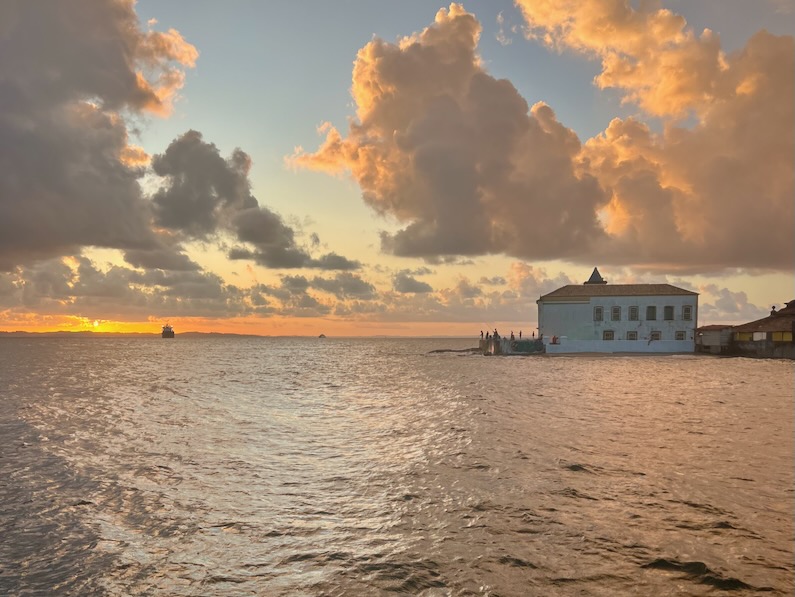
Original blue tiles in the Igreja e Convento de São Francisco
Dinner at Cuco Bistrô
The second day in Salvador ends with dinner at Cuco Bistrô. The menu is very large, featuring several Bahian and Brazilian-inspired cuisine options.
To drink, I recommend the Cuca Fresca with cachaça, infused hibiscus, lime and sugar or a Caipirinha Especial with cachaça artesanal, lime, jabuticaba, cravo, and sugar.
If you come hungry, start with the Matulão: grilled queijo coalho (a type of cheese in Brazil that is grilled over charcoal) with banana puree and honey.
Main dish recommendations include the codorna or quail wrapped in bacon and stuffed with housemade farofa and served with mushrooms or for something simpler, steak au gratin with potatoes.
Leave room for dessert and order the house’s special marquise de tapioca. This heavenly dessert is a lightly fried tapioca cake and served with coconut ice cream, ginger and doce de leite syrup and coconut milk. It was honestly one of the best desserts I’ve ever eaten.
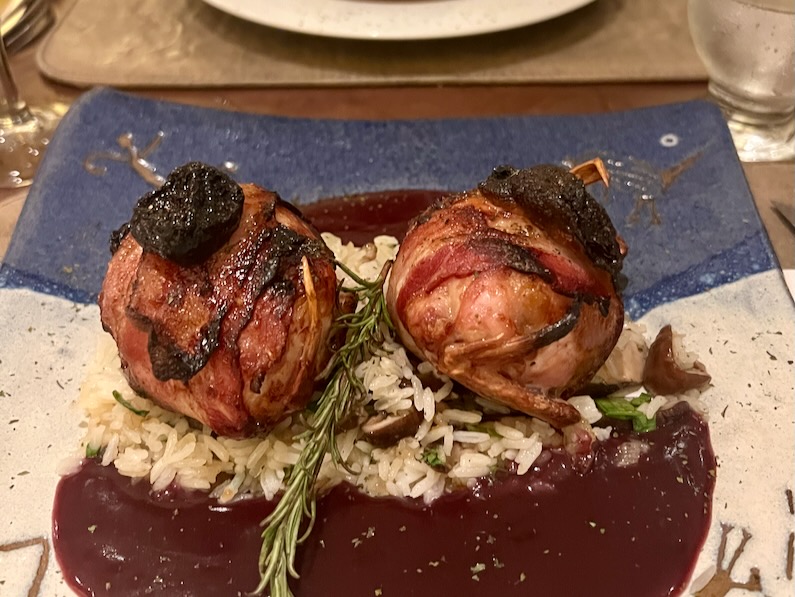
Day 3 in Salvador
Capoeira Lesson
Start the day with a 1-hour Capoeira lesson at the Barra Lighthouse, the southernmost tip of Salvador’s peninsula.
Before visiting Salvador, we knew very little about Capoeira. It is a mix of dance and martial arts created by slaves in Brazil as a way to practice self-defense.
Capoeira, once banned, is now recognized as an official sport and cultural practice in Brazil.
The 1-hour class was a fun and easy way to not only learn more about the history of the foundational movements and their symbolism in Capoeira but also put them to practice.
Since the lesson takes place outside, expect a small audience to gather by the end. But the experience is well worth any momentary embarrassment.
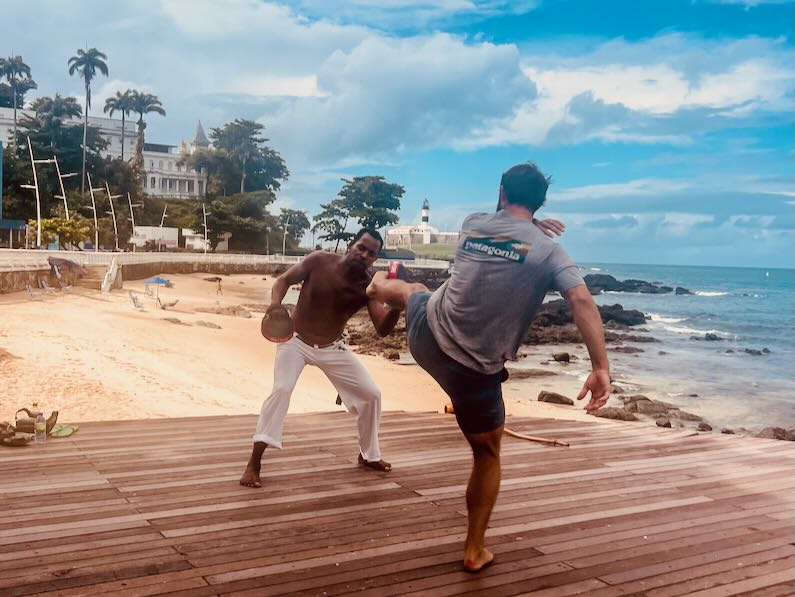
Capoeira Lesson in front of the Barra Lighthouse
Santo Antonio Fort
Following our Capoeira lesson, expore the first lighthouse to be operated in the Americas: Farol da Barra or the Barra Lighthouse.
Inaugurated in 1688, the grounds and scenery around the lighthouse are beautiful.
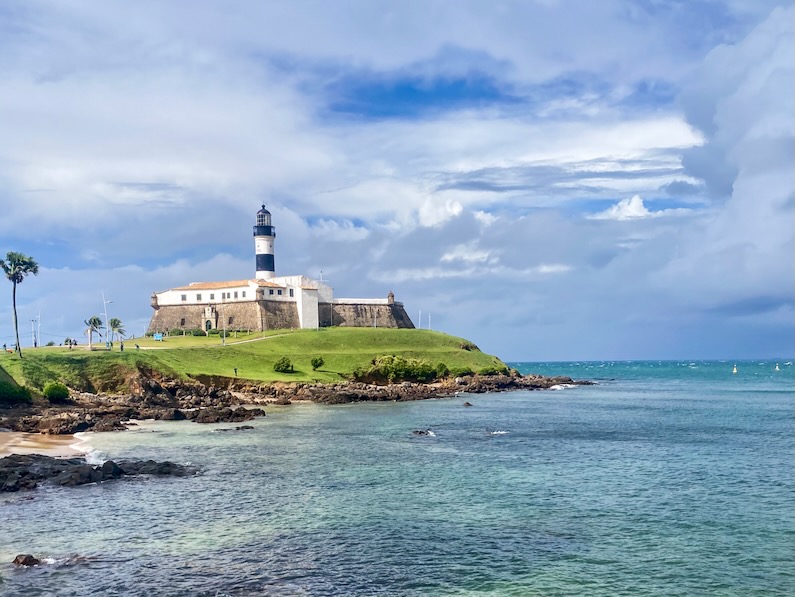
Inside the Santo Antonio Fort, where the lighthouse is located, there is the Bahia Nautical Museum.
Plan to spend 45 minutes to an hour browsing the museum which features maritime and military history during Salvador’s time as Brazil’s capital. The exhibits also include nautical instruments, maps, and ship renderings.
The climb and entry fee pay off with a stunning view from the top of the Barra Lighthouse.
Entry to the museum and lighthouse is R$15 for adults and free for kids under seven. Its exhibits are in Portuguese, Spanish and English.
Praia do Farol da Barra
Leaving the Barra Lighthouse, walk along the boardwalk that follows the Praia do Farol da Barra until Morro do Cristo.
Praia do Farol da Barra is a pleasant beach option if you are looking for a beach close to the city center.
Morro do Cristo is a small monument on a hill that offers a picturesque view of the beach and lighthouse.

Praia do Farol da Barra
Rio Vermelho Neighborhood
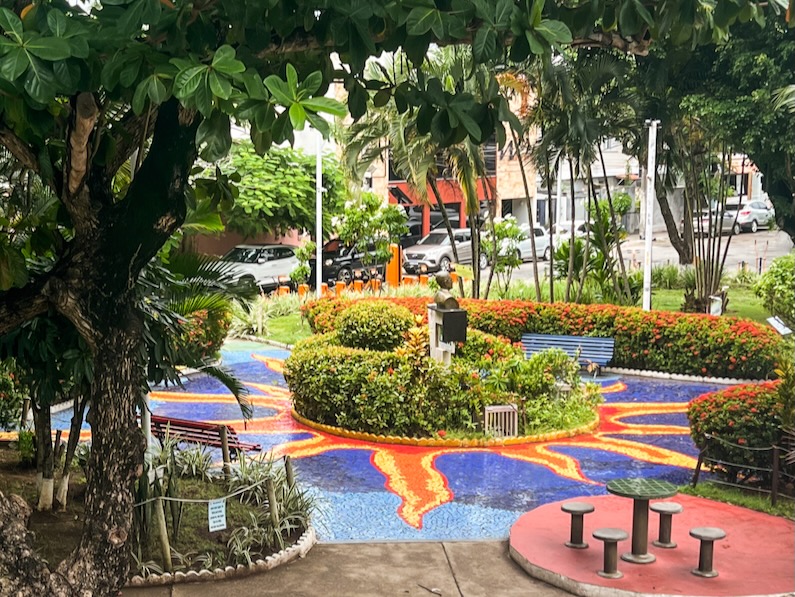
Colorful park in Rio Vermelho
Rio Vermelho is one of Salvador’s more hip and eclectic neighborhoods. Its streets are full of restaurants, bars, and food stands that become especially lively at night.
This area of Salvador is an excellent place to stay if you want to be close to the nightlife and have access to a variety of restaurant options.
Since we had plans to go to the Balé Folclórico that evening in Pelourinho, I knew this was our only chance to visit Rio Vermelho. We were also eager to finally get a taste of some famous acarajé.
In a planning mishap, we missed the small detail that the acarajé stand most highly recommended to us, Acarajé da Cira, didn’t open until 3pm.
Needing something to eat following our Capoeira lesson and walking from the lighthouse, we made the easy decision to regroup at a local brewery – ArtMalte.
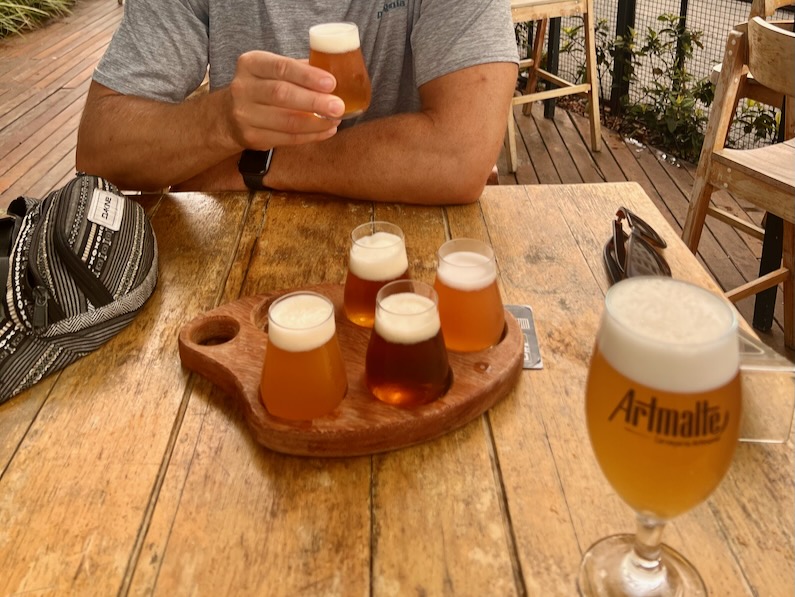
A Casa do Rio Vermelho
A Casa do Rio Vermelho is a museum that was once the home of the famous Brazilian writers Jorge Amado and his wife Zélia.
The home is said to be preserved exactly the way it was lived in by the couple. It is full of art and artifacts from their storied life together.
Unfortunately, almost all of the museum is in Portuguese. If you’re a non-Portuguese speaker but are a fan of Jorge Amado’s work or a fellow writer, I believe the museum is still worth visiting.
It has a similar vibe to the Frida Kahlo Museum in Mexico City.
Acarajé da Cira
Acarajé is Bahian street food typically consisting of a dendê (palm oil) fried bean fritter that is stuffed with a tomato salad, shrimp (usually with their tail casings intact), and a spicy pepper sauce.
There are a couple famous acarjé stands in Salvador but I recommend Acarajé da Cira.
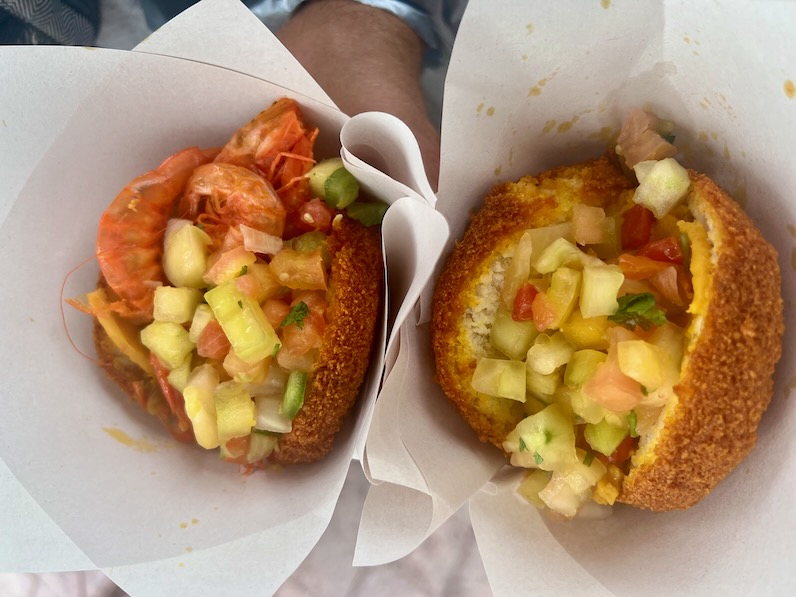
Acarajé
Happy Hour in Perlourinho
Before the Balé Folclórico, visit two very different bars in Pelourinho for appetizers and happy hour.
The first is O Cravinho, a bar known for its infused cachaças. Cachaça is Bazil’s national liquor and the main ingredient in a Caipirinha.
Here I recommend sampling the bar’s namesake, O Cravinho, which is cachaça infused with cloves, honey and lime.
After O Cravinho, walk up the hill a little bit to Antique Bistrô. Antique Bistrô is one of the best bars to watch the sunset in Pelourinho.
Balé Folclórico da Bahia
As a former dancer and someone with a strong interest in culture and art, seeing the Balé Folclórico da Bahia was a must do in Salvador.
The Balé Folclórico da Bahia considers itself a folk dance company. It was founded in 1988 to preserve and share the rich way of life and culture in Bahia through music and movement.
In addition to its weekly performances at the Miguel Santana Theater in Perlourinho, the company also tours worldwide.
Following our Capoeira lesson, it was especially cool to see professionals perform the dance and fight movements we had sorely attempted earlier in the day.
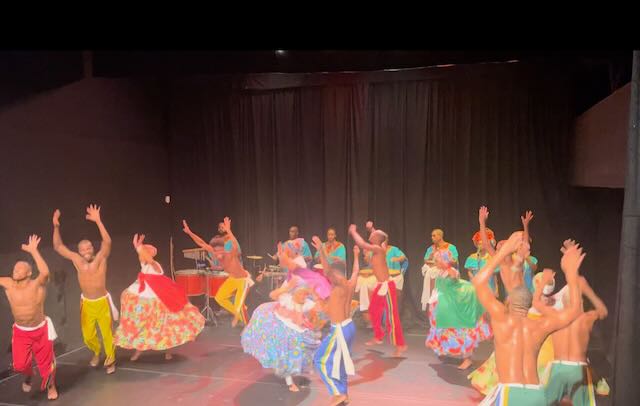
Tickets for the performance can be purchased directly from the box office the day-of. If seeing a performance by the Balé Folclórico is a priority, don’t wait to buy tickets since they can sell out. Tickets can also be reserved online.
Tickets cost R$80 (2024) and they have shows every Monday, Tuesday, and Friday at 7pm.
The Miguel Santana Theater is very small and seating in amphitheater style with no assigned seats or seat backs. A line forms at the door before 7 pm and seats are first come, first serve.
The theater provides a performance program that explains in English the 4 different acts of Balé Folclórico’s show so the audience can easily follow along.
Seeing the performers in costume, hearing the live musical instruments, and feeling the energy up close is an awesome way to close out your time in Salvador.
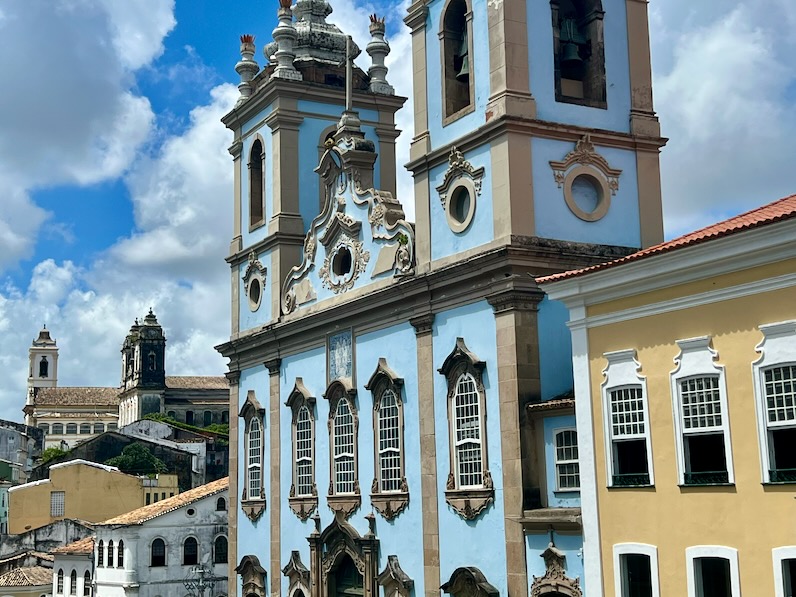
Other Things to Do & See in Salvador
Below are more ideas to add to your itinerary in Salvador.
- Afro-Brazilian hand drums church service at Igreja Nossa Senhora do Rosário dos Pretos.
- Explore the history of music in Salvador and Bahia at the Cidade da Música da Bahia museum.
- If you can’t make it to Salvador for Carnival, check out the Carnival Museum on your visit: Casa do Carnaval da Bahia.
- Ride the first outdoor public elevator in the world: Elevador Lacerda.
- Browse for souvenirs at the Mercado Modelo.
- Relax at one of many beaches along Salvador’s coastline.
Where to Stay in Salvador
High-end hotels with rooftop pools and views near Pelourinho:
Hotels in Pelourinho:
Hotels in Rio Vermelho:
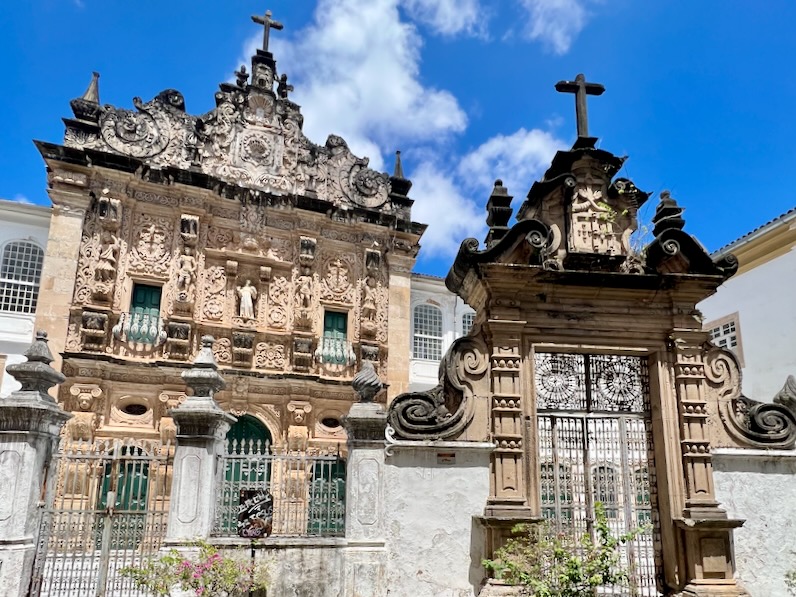
Where to Eat in Salvador
Perlourinho Neighborhood:
- Amado
- Ré Restaurante Dona Suzana
- Cafélier
- Café e Cana Botequim
- Restaurante Escola Senac
- Antique Bistrô
- O Cravinho
- Cuco Bistrô
Rio Vermelho Neighborhood:
Helpful Portuguese vocabulary to know while visiting Salvador
Igreja = church
Praça = plaza or square
Museu = museum
Forte = Fort

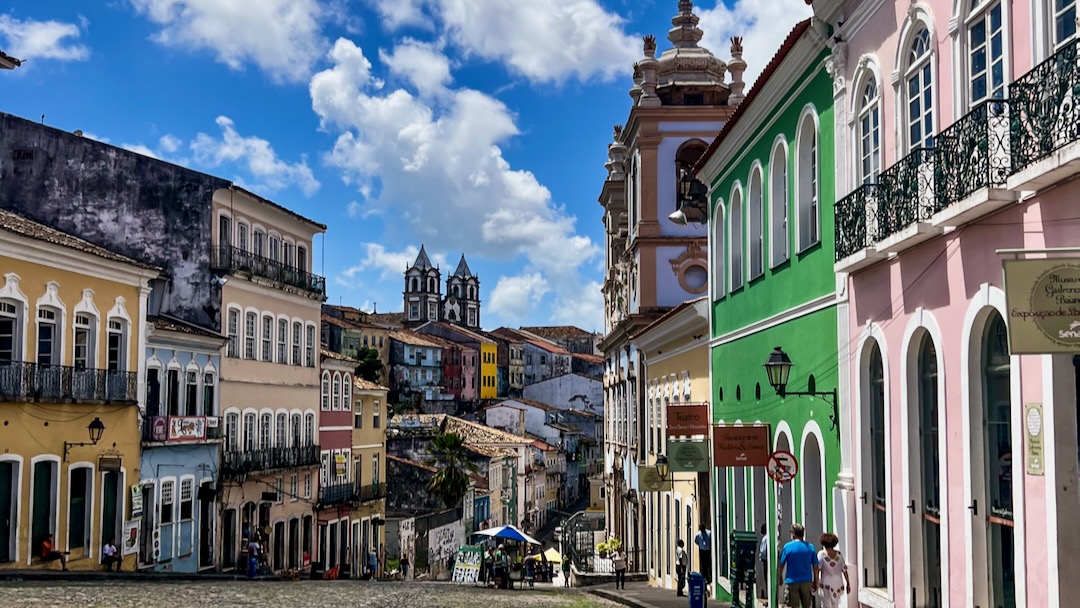
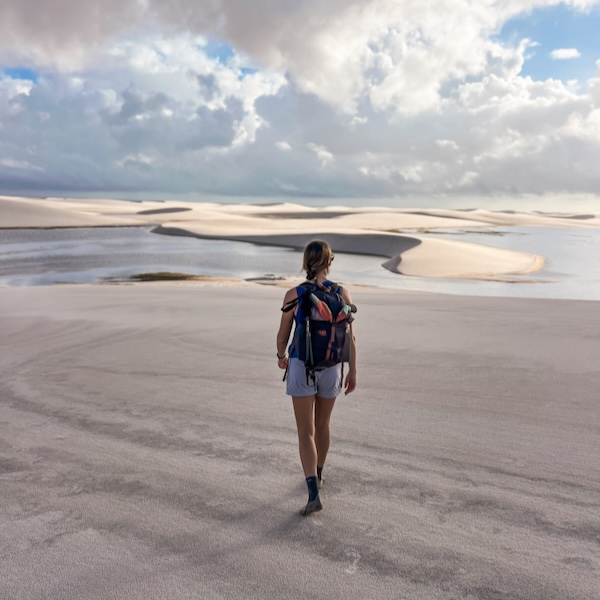


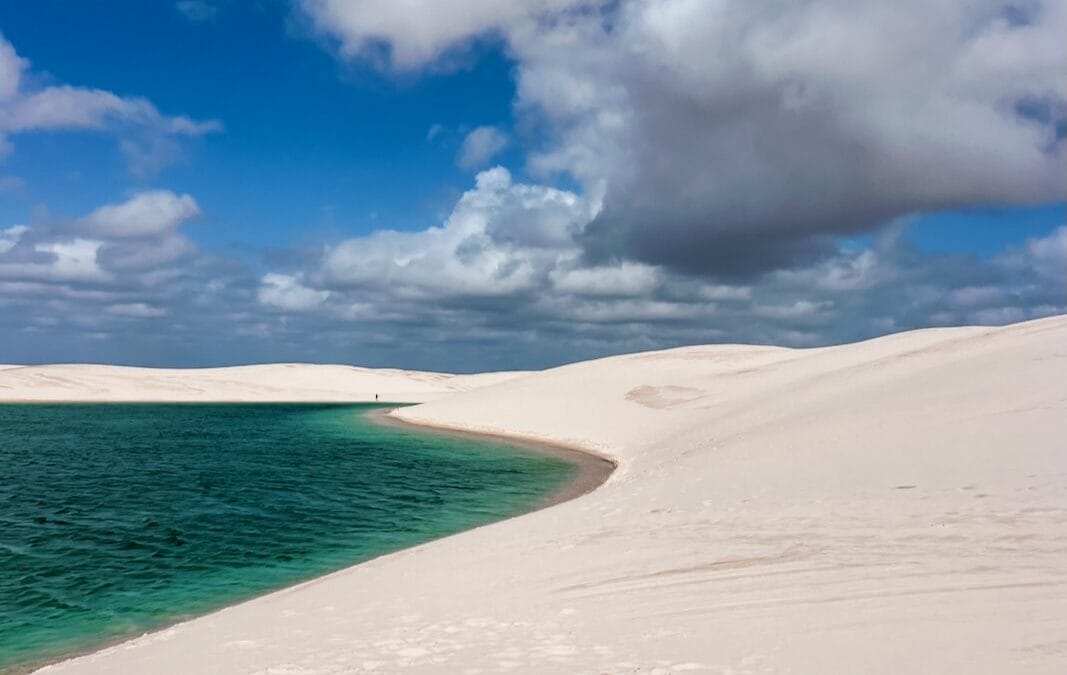
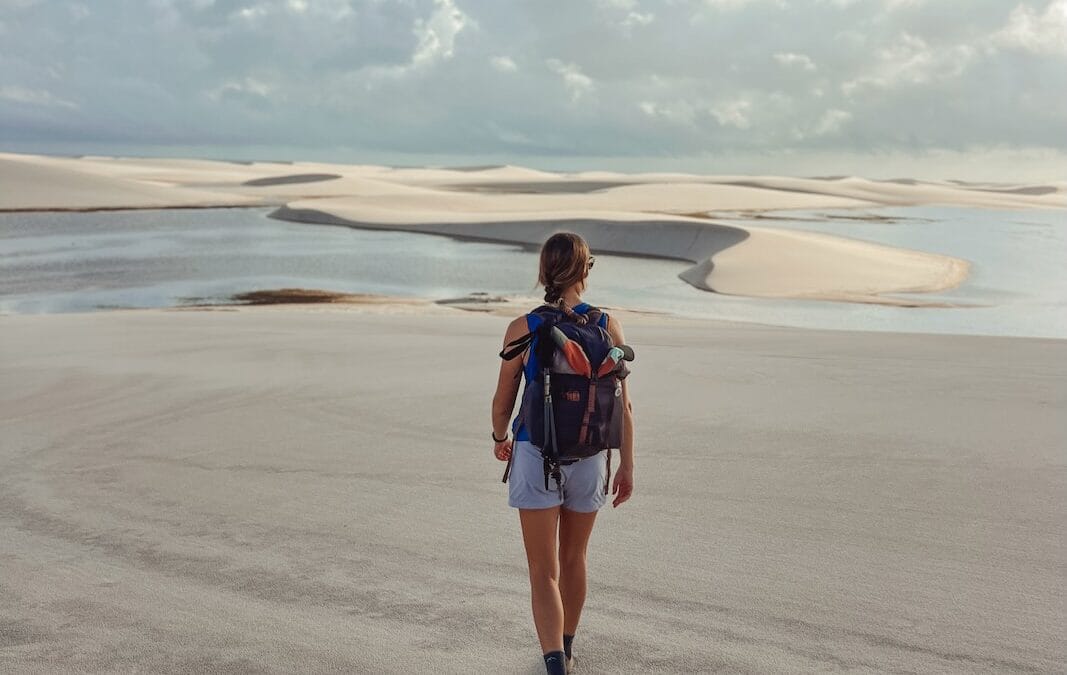
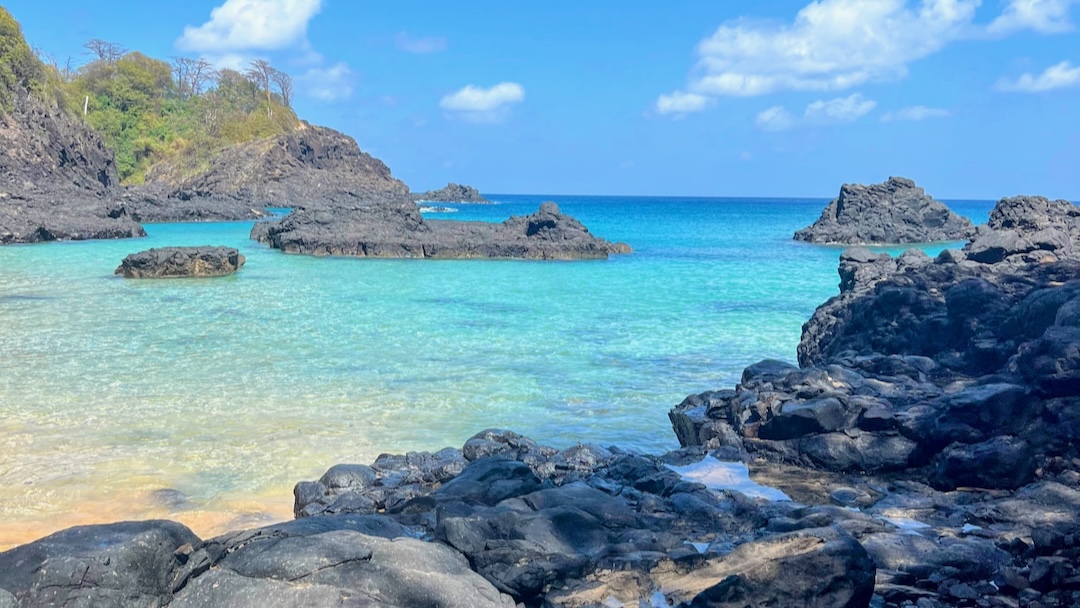
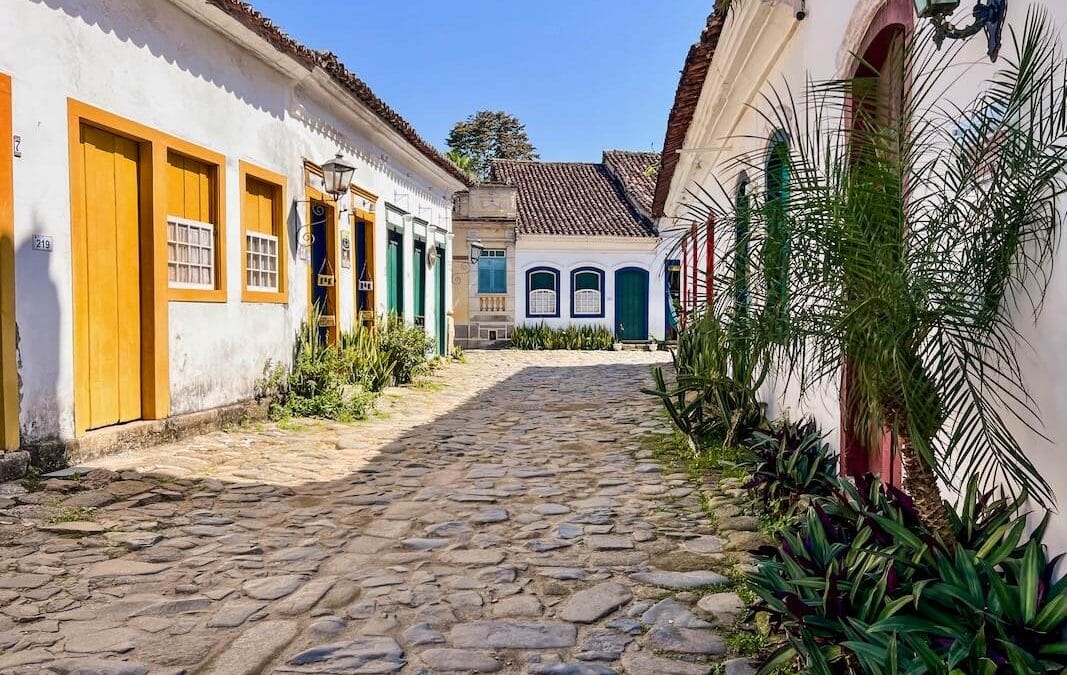
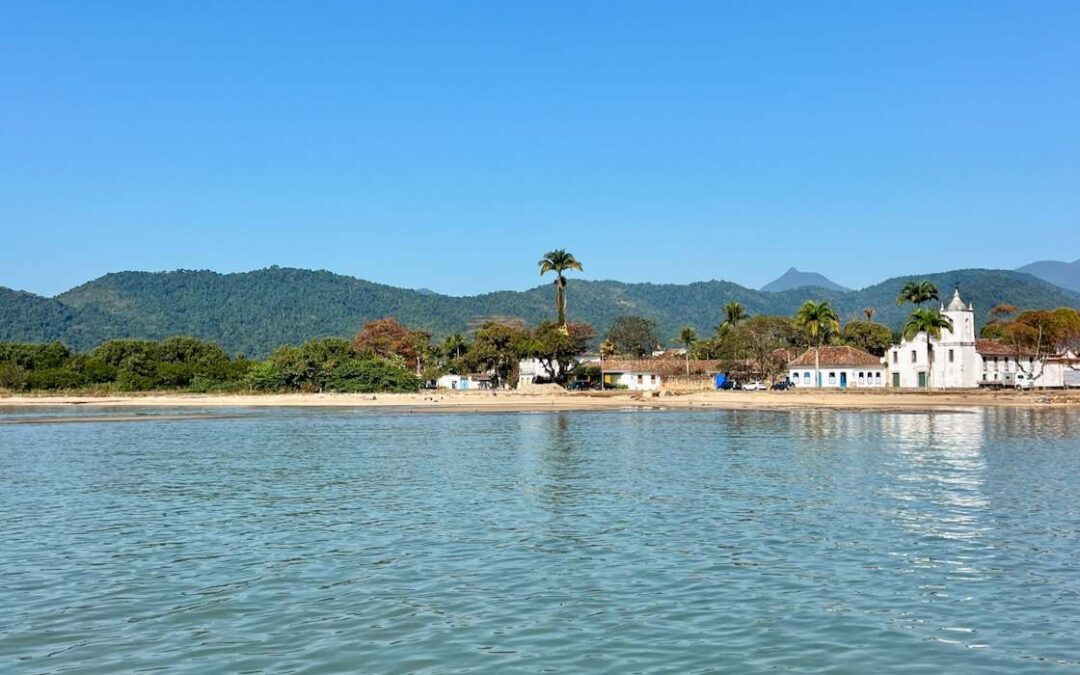
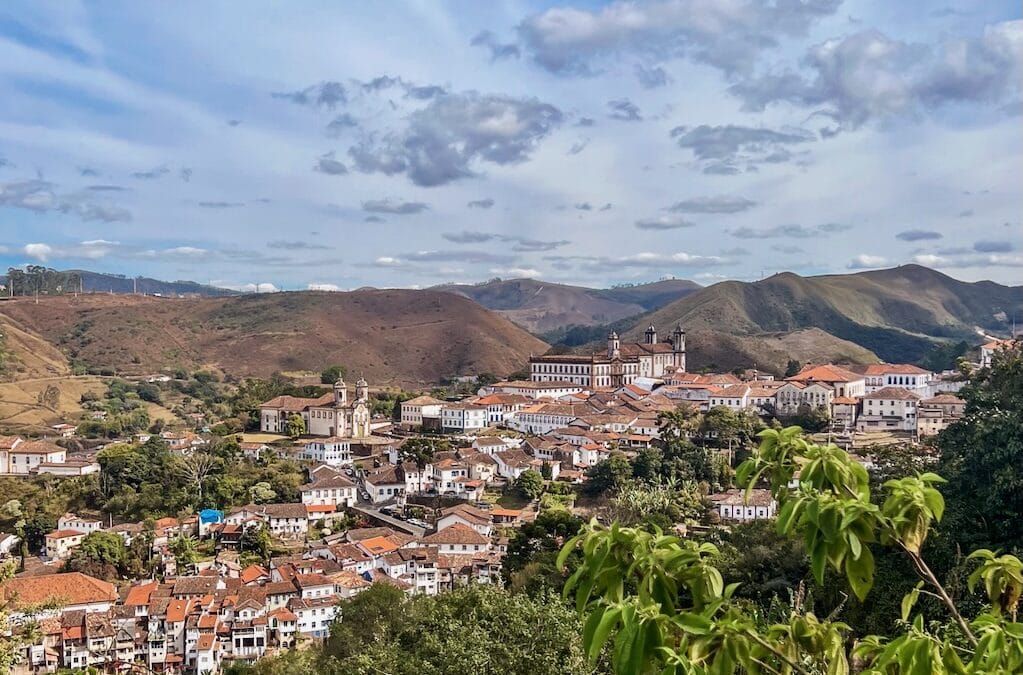
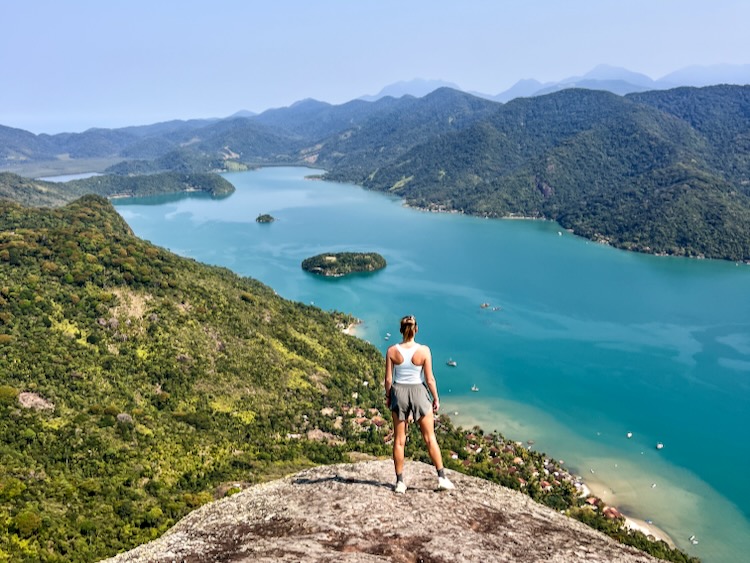
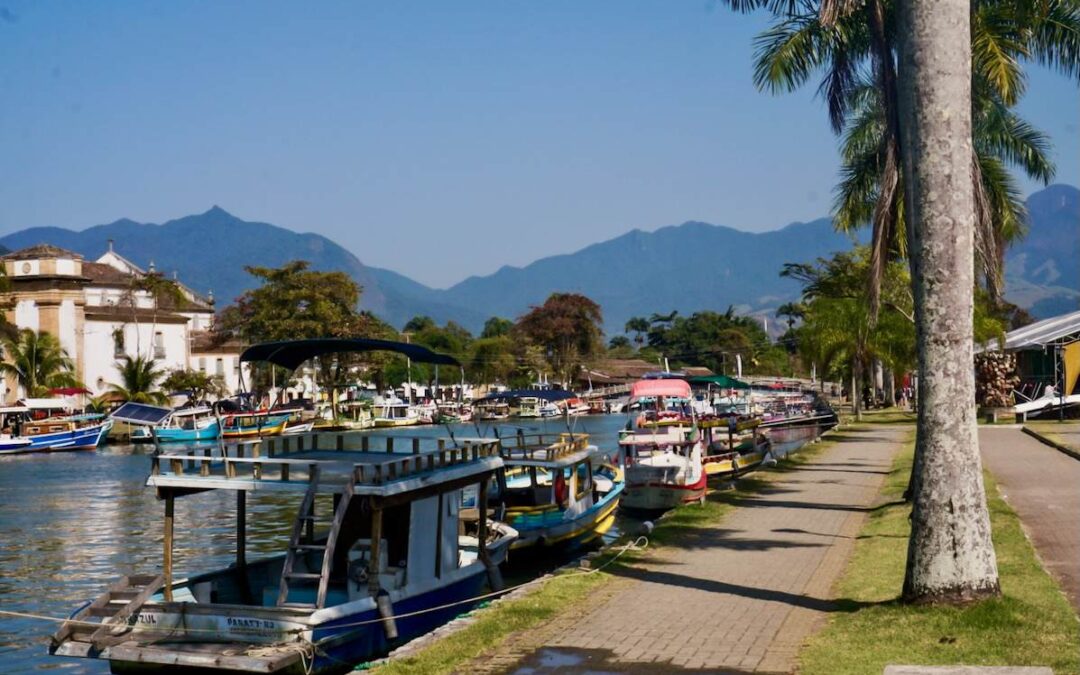
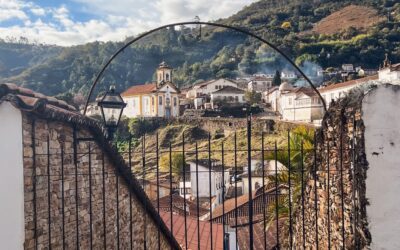
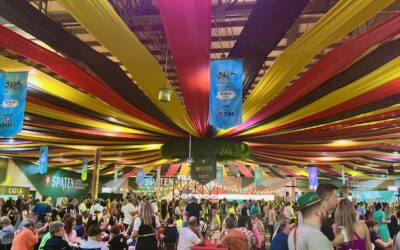
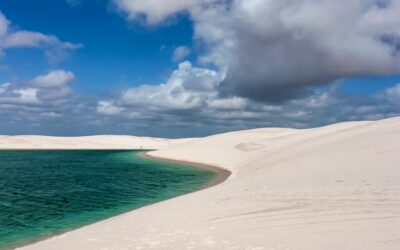
0 Comments